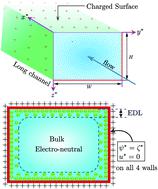当前位置:
X-MOL 学术
›
Soft Matter
›
论文详情
Our official English website, www.x-mol.net, welcomes your
feedback! (Note: you will need to create a separate account there.)
Electrokinetics of polymeric fluids in narrow rectangular confinements
Soft Matter ( IF 2.9 ) Pub Date : 2021-08-24 , DOI: 10.1039/d1sm00537e Aditya Natu 1 , Uddipta Ghosh 1
Soft Matter ( IF 2.9 ) Pub Date : 2021-08-24 , DOI: 10.1039/d1sm00537e Aditya Natu 1 , Uddipta Ghosh 1
Affiliation

|
The flow of polymeric liquids in narrow confinements with a rectangular cross section, in the presence of electrical double layers is analyzed here. Our analysis is motivated by the fact that many of the previous studies on the flow of complex fluids tend to focus on highly idealized parallel plate channels, which are markedly different from the rectangular ducts, used in many experiments and devices. We consider the combined electroosmotic and pressure driven flows as well as the streaming potential resulting from a mechanically driven flow. We use two distinct constitutive relations to model the polymeric liquids, namely the simplified exponential Phan-Thien-Tanner (sePTT) model and the Giesekus model, both of which are non-linear viscoelastic models, capable of capturing the shear thinning behavior. We establish that the applied electric field may have a strong influence on the overall flow rate, which rapidly increases with the field strength as well as the extent of viscoelasticity of the fluid. Viscoelasticity and shear thinning behavior also enhance the streaming potential by several fold as compared to a Newtonian medium. We demonstrate that the aspect ratio of a channel has a bigger influence on the net throughput and the streaming potential, when the extent of viscoelasticity is relatively large. We illustrate that for sePTT fluids, the flow is strictly unidirectional, while for Giesekus fluids, secondary flows are inevitably present on account of their non-zero second normal stress coefficient. Although the electric field does not change the overall patterns of these secondary flows, their magnitude does depend on the imposed field strength for combined flows.
中文翻译:

窄矩形约束中聚合物流体的电动学
这里分析了在具有双电层的情况下,聚合物液体在矩形横截面的狭窄范围内的流动。我们的分析受到以下事实的启发:之前关于复杂流体流动的许多研究往往集中在高度理想化的平行板通道上,这些通道与许多实验和设备中使用的矩形管道明显不同。我们考虑了电渗和压力驱动流的组合以及机械驱动流产生的流动电位。我们使用两种不同的本构关系来模拟聚合物液体,即简化的指数 Phan-Thien-Tanner (sePTT) 模型和 Giesekus 模型,这两种模型都是非线性粘弹性模型,能够捕捉剪切稀化行为。我们确定施加的电场可能对总流速有很大影响,它随着场强以及流体粘弹性的程度而迅速增加。与牛顿介质相比,粘弹性和剪切稀化行为也将流动潜力提高了几倍。我们证明,当粘弹性程度相对较大时,通道的纵横比对净吞吐量和流媒体潜力有更大的影响。我们说明,对于 sePTT 流体,流动是严格单向的,而对于 Giesekus 流体,由于其非零的第二法向应力系数,二次流动不可避免地存在。虽然电场不会改变这些二次流的整体模式,
更新日期:2021-09-15
中文翻译:

窄矩形约束中聚合物流体的电动学
这里分析了在具有双电层的情况下,聚合物液体在矩形横截面的狭窄范围内的流动。我们的分析受到以下事实的启发:之前关于复杂流体流动的许多研究往往集中在高度理想化的平行板通道上,这些通道与许多实验和设备中使用的矩形管道明显不同。我们考虑了电渗和压力驱动流的组合以及机械驱动流产生的流动电位。我们使用两种不同的本构关系来模拟聚合物液体,即简化的指数 Phan-Thien-Tanner (sePTT) 模型和 Giesekus 模型,这两种模型都是非线性粘弹性模型,能够捕捉剪切稀化行为。我们确定施加的电场可能对总流速有很大影响,它随着场强以及流体粘弹性的程度而迅速增加。与牛顿介质相比,粘弹性和剪切稀化行为也将流动潜力提高了几倍。我们证明,当粘弹性程度相对较大时,通道的纵横比对净吞吐量和流媒体潜力有更大的影响。我们说明,对于 sePTT 流体,流动是严格单向的,而对于 Giesekus 流体,由于其非零的第二法向应力系数,二次流动不可避免地存在。虽然电场不会改变这些二次流的整体模式,











































 京公网安备 11010802027423号
京公网安备 11010802027423号